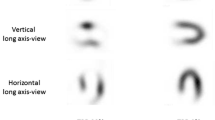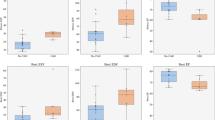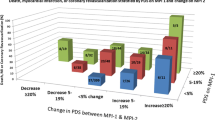Abstract
Purpose
Estimate myocardial salvage index (MSI) using a single-gated Single-Photon Emission Computed Tomography (SPECT) myocardial perfusion imaging (GSMPI) early after percutaneous coronary intervention (PCI) in patients with acute myocardial infarction (AMI) and compare its predictive value with the traditional method especially for post-PCI left ventricular ejection fraction (LVEF) improvement and major adverse cardiac events (MACEs).
Methods
GSMPI was performed in 62 patients with AMI early after PCI (3–10 days). The MSI and the conventional parameters were obtained, including total perfusion deficit, LVEF, peak ejection rate (PER), and peak filling rate (PFR). The new calculation method (scoring evaluation method means the extent of abnormality is the percentage of the total scores of abnormal segments divided by the sum of the maximum scores of all myocardial segments using 4-point and 5-point scale semi-quantitative scoring method) and the reference method (number evaluation method means the extent of abnormality is the percentage of the number of abnormal segments divided by the total number of myocardial segments) were applied to acquire the MSI. We compared the predictive ability of the 2 methods based on the area under the receiver operating characteristic curve for LVEF improvement 6 months after PCI using MSI. The Kaplan–Meier method was used for depicting survival curves for predicting MACEs by the 2 methods. Cox proportional-hazards regression was applied to confirm the independent predictors of MACEs.
Results
The MSI obtained by the new method indicated stronger prognostic significance in LVEF improvement [area under the curve (AUC): 0.793, 95% confidence interval (CI) 0.620–0.912, P < .001] compared with the reference method (AUC: 0.634, 95%CI 0.452–0.792, P = .187). Delong’s test revealed a statistically significant difference in AUCs between the 2 methods (P < .05, 95%CI 0.003–0.316). The diagnostic value of the scoring evaluation method was higher than that of the number evaluation method. The Cox prevalence of MACEs was substantially higher in the < median MSI group than in the ≥ median MSI group (hazard ratio: 0.172; 95% CI 0.041–0.724; P < .05] using the new method, whereas no considerable differences were observed between the 2 groups using the reference method (P = .12). Further, the multivariate Cox regression analysis revealed that MSI was an independent indicator for predicting MACEs (P < .05).
Conclusion
The MSI obtained from a simple GSMPI early after PCI, using the scoring evaluation method, was a reliable prognostic indicator for predicting LVEF improvement and MACEs in AMI. It remarkably improved the prognostic value compared with the previous reference methods.





Similar content being viewed by others
References
Fan ZY, Wu CW, Wesemann LD, Ouchi E, Bautista M, Qiu J, Xu JR, Zhou Y, Wu LM. Predictive value of major adverse cardiac events by T2-mapping texture analysis of the myocardial remote zone in patients with acute myocardial infarction. Clin Radiol. 2022;77(3):e241–9. https://doi.org/10.1016/j.crad.2021.12.015.
Fan ZY, Wu CW, An DA, et al. Myocardial area at risk and salvage in reperfused acute MI measured by texture analysis of cardiac T2 mapping and its prediction value of functional recovery in the convalescent stage. Int J Cardiovasc Imaging. 2021;37(12):3549–60. https://doi.org/10.1007/s10554-021-02336-7.
Takehana K, Ruiz M, Petruzella FD, et al. Tc-99m sestamibi defect magnitude predicts the am-ount of viable myocardium after coronary reperfusion despite the presence of severe residual stenosis. J Nucl Cardiol. 2001;8(1):40–8. https://doi.org/10.1067/mnc.2001.110387.
Parodi G, Ndrepepa G, Kastrati A, et al. Beyond 12 hours Reperfusion AlternatiVe Evaluation (BRAVE-2) Trial Investigators. Ability of mechanical reperfusion to salvage myocardium in patients with acute myocardial infarction presenting beyond 12 hours after onset of symptoms. AM Heart J. 2006;152(6):1133–9. https://doi.org/10.1016/j.ahj.2006.08.007.
Busk M, Kaltoft A, Nielsen SS, Bøttcher M, et al. Infarct size and myocardial salvage after pri-mary angioplasty in patients presenting with symptoms for <12 h vs. 12–72 h. Eur Heart J. 2009; 30(11):1322–30. https://doi.org/10.1093/eurheartj/ehp113.
Kastrati A, Mehilli J, Dirschinger J, et al. Stent versus thrombolysis for occluded coronary ar-teries in patients with acute myocardial infarction (STOPAMI-2) Study. Myocardial salvage af-ter coronary stenting plus abciximab versus fibrinolysis plus abciximab in patients with acute myocardial infarction: a randomised trial. Lancet. 2002;359(9310):920–5. https://doi.org/10.1016/S0140-6736(02) 08022–4.
Ndrepepa G, Mehilli J, Schwaiger M, et al. Prognostic value of myocardial salvage achieved by reperfusion therapy in patients with acute myocardial infarction. J Nucl Med. 2004;45(5):725–9.
Engblom H, Aletras AH, Heiberg E, Arheden H, Carlsson M. Quantification of myocardial salv-alvage by myocardial perfusion SPECT and cardiac magnetic resonance-reference standards for ECG development. J Electrocardiol. 2014; 47(4):525–34. https://doi.org/10.1016/j.jelectrocard.2014.04.001.
Mochizuki T, Murase K, Higashino H, et al. Ischemic “memory image” in acute myocardial infarction of 123I-BMIPP after reperfusion therapy: a comparison with 99mTc-pyrophosphate and 201Tl dual-isotope SPECT. Ann Nucl Med. 2002;16(8):563–8. https://doi.org/10.1007/BF02988634.
Shibata N, Takagi K, Morishima I, et al. The impact of the excimer laser on myocardial salvage in ST-elevation acute myocardial infarction via nuclear scintigraphy. Int J Cardiovasc Imaging. 2020;36(1):161–70. https://doi.org/10.1007/s10554-019-01690-x.
Yoshida R, Takagi K, Ishii H, Morishima I, et al. Myocardial salvage after ST-segment-elevation myocardial infarction: comparison between prasugrel and clopidogrel in the presence or absence of high-residual platelet reactivity. J Nucl Cardiol. 2021;28(4):1422–34. https://doi.org/10.1007/s12350-019-01852-3.
Wakabayashi H, Taki J, Mori H, et al. Visualization of Dynamic Expression of Myocardial Sig-ma-1 receptor after myocardial ischemia and reperfusion using radioiodine-labeled2-[4-(2-iodophenyl) piperidino] cyclopentanol (OI5V) imaging. Circ J. 2021;85(11):2102–108. https://doi.org/10.1253/circj.CJ-21-0320.
Qin H, Li S, Liu Z. Protective effect of shexiang baoxin pill on myocardial ischemia/reperfusi-on injury in patients with STEMI. Front Pharmacol. 2021;10(12): 721011. https://doi.org/10.3389/fphar.2021.721011.
Sotgia B, Sciagrà R, Parodi G, Kastrati A, Antoniucci D, Schömig A, Pupi A. Estimate of myocardial salvage in late presentation acute myocardial infarction by comparing functional and perfusion abnormalities in predischarge gated SPECT. Eur J Nucl Med Mol Imaging. 2008;35(5):906–11. https://doi.org/10.1007/s00259-007-0663-3.
Sciagrà R, Dona M, Coppola A, Leoncini M, Maioli M, Castagnoli A, Bellandi F, Pupi A. Feasi-bility of an accurate assessment of myocardial salvage by comparing functional and perfusion a-bnormalities in post-reperfusion gated SPECT. J Nucl Cardiol. 2010;17(5):825–30. https://doi.org/10.1007/s12350-010-9247-x.
Calabretta R, Castello A, Linguanti F, et al. Prediction of functional recovery after primary PCI using the estimate of myocardial salvage in gated SPECT early after acute myocardial infarction. Eur J Nucl Med Mol Imaging. 2018;45(4):530–7. https://doi.org/10.1007/s00259-017-3891-1.
Romero-Farina G, Aguadé-Bruix S, Candell-Riera J, et al. Acute myocardial infarction: estimation of at-risk and salvaged myocardium at myocardial perfusion SPECT 1 month after infarction. Radiology. 2013;269(2):577–84. https://doi.org/10.1148/radiology.13122324.
Thygesen K, Alpert JS, Jaffe AS, et al. Executive Group on behalf of the Joint European Society of Cardiology (ESC)/American College of Cardiology (ACC)/American Heart Association (AH- A)/World Heart Federation (WHF) Task Force for the Universal Definition of Myocardial Infarction. Fourth Universal Definition of Myocardial Infarction. J Am Coll Cardiol. 2018;72(18):2231–64. https://doi.org/10.1016/j.jacc.2018.08.1038.
Poli A, Fetiveau R, Vandoni P, et al. Integrated analysis of myocardial blush and ST-segment elevation recovery after successful primary angioplasty: real-time grading of microvascular reperfusion and prediction of early and late recovery of left ventricular function. Circulation. 2002;106(3):313–8. https://doi.org/10.1161/01.cir.0000022691.71708.94.
Ganz W. The thrombolysis in myocardial infarction (TIMI) trial. Phase I findings. TIMI Study Group. New England J Med 1985;313(16):1018. 10. 1056/NEJM198510173131611.
Jeremias A, Davies JE, Maehara A, Matsumura M, Schneider J, et al. Blinded physiological assessment of residual ischemia after successful angiographic percutaneous coronary intervention: The DEFINE PCI study. JACC Cardiovasc Interv. 2019. https://doi.org/10.1016/j.jcin.2019.05.054.
Bestetti A, Cuko B, Decarli A, Galli A, Lombardi F. Additional value of systolic wall thickening in myocardial stunning evaluated by stress-rest gated perfusion SPECT. J Nucl Cardiol. 2019;26(3):833–40. https://doi.org/10.1007/s12350-017-1115-5.
Bestetti A, Cuko B, Gasparini M, De Servi S. Better characterization of dipyridamole-induced myocardial stunning by systolic wall thickening. A gated perfusion SPECT study. J Nucl Cardiol. 2020;27(1):137–146. https://doi.org/10.1007/s12350-018-1340-6.
Sharir T. What is the value of motion and thickening in gated myocardial perfusion SPECT? J Nucl Cardiol. 2018;25(3):754–7. https://doi.org/10.1007/s12350-018-1239-2.
Miller RJH, Klein E, Gransar H, et al. Prognostic significance of previous myocardial infarction and previous revascularization in patients undergoing SPECT MPI. Int J Cardiol. 2020;3(13):9–15. https://doi.org/10.1016/j.ijcard.2020.04.012.
Kloner RA. Stunned and hibernating myocardium: where are we nearly 4 decades later? J Am Heart Assoc. 2020;9(3): e015502. https://doi.org/10.1161/JAHA.119.015502.
Ambrosio G, Zweier JL, Jacobus WE, Weisfeldt ML, Flaherty JT. Improvement of postischemic myocardial function and metabolism induced by administration of deferoxamine at the time of reflow: the role of iron in the pathogenesis of reperfusion injury. Circulation. 1987;76(4):906–15. https://doi.org/10.1161/01.cir.76.4.906.
Pellikka PA, Behrenbeck T, Verani MS, Mahmarian JJ, Wackers FJ, Gibbons RJ. Serial changes in myocardial perfusion using tomographic technetium-99m-hexakis-2-methoxy-2-methylpropyl- isonitrile imaging following reperfusion therapy of myocardial infarction. J Nucl Med. 1990;31(8):1269–75.
Acknowledgements
I would like to thank my supervisor, Professor Xu, for his guidance through each stage of the process. I would like to acknowledge Professor Gao, for inspiring my interest in the development of innovative technologies. My research partner, Dr Dou, was instrumental in defining the path of my research. For this, I am extremely grateful. We declare that we have no financial and personal relationships with other people or organizations that can inappropriately influence our work. There is no professional or other personal interest of any nature or kind in any product, service and/or company that could be construed as influencing the position presented in, or the review of, the manuscript entitled.
Funding
This study was supported by the Key Project of Scientific and Technological Support Plan of Tianjin in 2020 (No. 20YFZCSY00820), the Key Disciplines of Tianjin Health Research Project (No. TJWJ2022XK032), and the Key Projects of Tianjin Natural Science Foundation (No. 22JCZDJC00130).
Author information
Authors and Affiliations
Corresponding authors
Additional information
Publisher's Note
Springer Nature remains neutral with regard to jurisdictional claims in published maps and institutional affiliations.
Rights and permissions
Springer Nature or its licensor (e.g. a society or other partner) holds exclusive rights to this article under a publishing agreement with the author(s) or other rightsholder(s); author self-archiving of the accepted manuscript version of this article is solely governed by the terms of such publishing agreement and applicable law.
About this article
Cite this article
Li, T., Dou, J., Zhang, H. et al. Optimized gated a SPECT-derived myocardial salvage index: its prognostic significance in predicting major adverse cardiac events following acute myocardial infarction percussion. Ann Nucl Med 38, 219–230 (2024). https://doi.org/10.1007/s12149-023-01894-1
Received:
Accepted:
Published:
Issue Date:
DOI: https://doi.org/10.1007/s12149-023-01894-1




